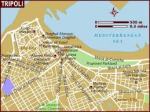
I always wondered why the capital of Libya was named Tripoli. The name did not sound so ‘Arabic’ or ‘Berber’ to me… and I always thought that maybe the name had some Italian origin, since Libya was once part of the Roman empire, and later in the 19th/20th centuries an Italian colony.
Tripoli, or Tarabulus in Arabic, is known as Tripoli-of-the-West, to distinguish it from its ancient Phoenician sister city of Tripoli in Lebanon which means Levantine Tripoli or Tripoli of the East. Tripoli, Libya, is affectionately called the Mermaid of the Mediterranean (arusat-el-bahr: bride of the sea) describing its turquoise waters and its whitewashed buildings. In reality, Tripoli is a Greek name which means “Three Cities” (Tria for three, Polis for city) in reference to the Libyan province of Tripolitaine encompassing the three cities of Oea (modern-day Tripoli), Leptis Magna, and Sabratha.

Tripoli is located in the north west of the country. It extends to the edges of the desert, on a rocky piece of land jutting out into the Mediterranean sea, forming a bay. Tripoli was founded in the 7th century BC, by the Phoenicians, who gave it the Libyco-Berber name Oea (or Wy’t), probably built upon a native Berber town. The Phoenicians were probably attracted to the site by its natural harbor, flanked on the western shore by the small, easily defensible peninsula, on which they established their colony. The city was then taken by the rulers of Cyrenaica (a Greek colony on the North African shore, east of Tripoli, halfway to Egypt), although the Carthaginians later wrested it from the Greeks. Around the 2nd century BC, Tripoli belonged to the Romans, who included it in their province of Africa, and gave it the name of Regio Syrtica. Around the beginning of the 3rd century AD, it became known as the Regio Tripolitana, meaning “region of the three cities“, namely Oea, Sabratha and Leptis Magna. It was later raised to the rank of a separate province by Septimius Severus, who was a native of Leptis Magna. Tripoli was later conquered by Muslim dynasties around the 8th century AD; it was temporarily part of the Berber Almohad empire and of the Hafsids kingdom. Tripoli was included in the Ottoman Empire between the 16th and 19th centuries AD.

With a population over 1.68 million (census before the 2011 NATO attacks on Libya) Tripoli is the largest city, the principal port, and the biggest industrial and commercial city of Libya. It is the heart of government and that of the prestigious university of Tripoli. Due to its long historical importance, Tripoli has a lot of archaelogical sites. Many of these sites (which were already derelict) were bombed by the NATO forces during their intervention in Libya 2011 against the government of Muammar Gaddafi.
True, the city today is very far from its splendid and beautiful self. Tripoli is healing its wounds today, which may take years or decades to heal, but I thought you would enjoy watching this 2010 video of Tripoli, the Mermaid of the Mediterranean!

